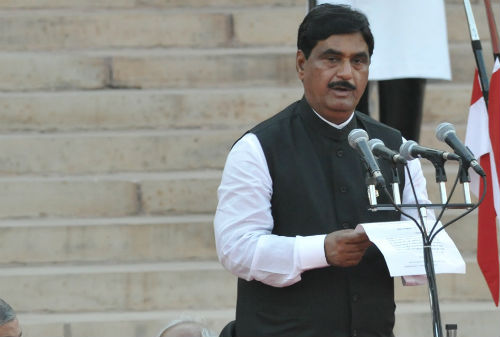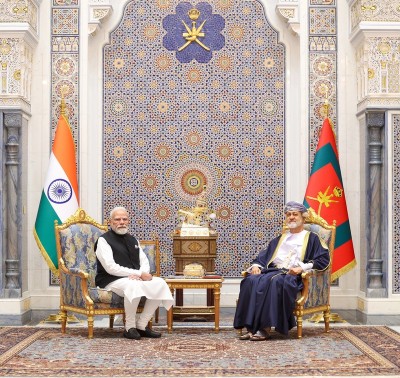December 20, 2025 10:25 pm (IST)

Wearing seat belt could have saved Munde: Health Minister
New Delhi, June 4 (IBNS) Union Health and Family Welfare Minister Harsh Vardhan on Wednesday confirmed reports in the media since Tuesday suggesting that Union minister Gopinath Munde could have prevented his own death by simply wearing the seat belt of his car.
Harsh Vardhan, before leaving for Beed district in Maharashtra for attending the funeral of the deceased Rural Development Minister, commented, “I lost my friend to a misconception. Most people think that the back-seat belts serve only a decorative purpose. In fact wearing them is as necessary as wearing front seat belts. They can save lives in the event of impacts.”
On Tuesday, Munde, died within seconds of his car being allegedly rammed from the side by a motorist who jumped lights.
The damage to the minister’s car was not great, but the force of the throw-forward within the confined space of the car damaged the atlanto axial joint in his neck, and severely injured the spinal cord.
The blood vessels carrying blood supply to the brain stem (which is the seat of respiratory and cardiac centre) got disrupted and this became a cause for immediate cardiac and respiratory arrest.
Besides, the liver was ruptured which caused profuse loss of blood, informed the Health Minister.
“I feel numbed by the realization that the nation has lost such a valuable mass leader and able minister with a proven track record in Maharashtra. I now realize the trauma of countless others whose near ones died in car crashes only because they had overlooked the importance of the seat belt”, Harsh Vardhan stated.
The Health Minister added that there have been many famous accident victims of this small but fatal negligence.
In August 1997, Princess Diana of Britain died when the car in which she was speeding crashed against a pillar of an underground pass in Paris.
Later it was confirmed that of the four inmates of the ill-fated car, the lone survivor, bodyguard Trevor Rees Jones, owed his escape to the fact that he wore a seat belt whereas the others – Princess Diana, her fiancé Dodi Fayed and driver Henri Paul – had all neglected wearing it, he stated.
Closer home in 2007, Sahib Singh Verma, a former Chief Minister of Delhi who was also a Cabinet Minister in Atal Bihari Vajpayee’s government, died in a road accident after a collision with a truck. He too could have lived had he been wearing a seat belt, Harsh Vardhan stated.
“It is a fallacy that Mundeji could have been saved because he had been found sitting inside the car and not thrown out. Actually the damage to the human body is often greater when the victim is not ejected from the vehicle. Internal organs are badly damaged then and scientific tests have proved that wearing safety belts give them hope of survival,” Harsh Vardhan said.
He remarked, “Seat belts when worn correctly save lives. Research in the UK has shown that wearing a seat belt reduces the risk of fatal injury to front seat passenger car occupants by 45 percent, and risk of moderate-to-critical injury by 50 percent. For those riding in the rear of vans and sport-utility vehicles (SUVs) during a car crash, rear seat belts are 73 percent better at preventing fatalities. Also, children are likely to be buckled 92 percent of the time when adults in the car use seat belts, as opposed to 72 percent of the time when adults are not using them.”
The Health Minister observed that the level of ignorance of the utility of safety belts is alarming.
“Many car owners cover the back seats of their cars with attractive cloth or other material to give comfort. In the process the seat belts get concealed. This fallacy is doubtless causing a lot of accident deaths”, he said.
The Minister recalled from history that by 1955, most developed countries had announced compulsory car seat belts. Their governments made rules to standardise the manufacturing of seat belts.
In contrast, India made seat belts compulsory only after the passing of the Motor Vehicles Act, 1989. It is still not seriously implemented, the Health Minister added.
Health Ministry to campaign
Harsh Vardhan stated that the Ministry of Health and Family Welfare would soon take the initiative to expose the people to safety protocols while driving.
A multi-media campaign in collaboration with NGOs working on safety is being considered, the Health Minister informed. “The focus would be the child victims of accidents –whether direct or as those left behind by a parent or both parents who did not care to be careful,” Dr Harsh Vardhan said.
Children also tend to worship the wrong role models. Instead of deifying those who drive or bike rashly, they should be exposed to the right way of life, he added.
The direct child victims of accidents represent a greater tragedy.
The World Health Organisation (WHO) recommends that children over the age of 10 should wear a seat belt and younger children should be in a child restraint. A report of UK’s Royal Society for the Prevention of Accidents stated that the car manufacturer Volvo’s patented three-point belt design had saved 1 million lives worldwide, the Health Minister pointed out.
He said it was a matter of concern that young people in India, like their counterparts all over the world, are nowadays manifesting disinterest towards seat belts and helmets (while riding motor bikes).
Research findings hold that the greatest reluctance is shown by women drivers and motorcyclists, especially when riding pillion, he pointed out. For this the number of female deaths has shown an increase in recent times disproportionate to their active role in urban traffic, stated the Health Minister.
There should also be a degree of coercion, the Minister felt.
Harsh Vardhan said, “I would like to seek the cooperation of the associations of petroleum dealers all over the country to utilise the pumps as points of interface with car and bike users. Perhaps a system could be developed under which petrol and diesel sales can be denied to those who don’t use seat belts and helmets. At any rate a new law is necessary along the lines of European Union countries to make non-seat belt and helmet use punishable.”
He also said that apart from ignoring seat belts, the new generation of drivers and bikers speak on mobile phones and even text while on the wheel. This is so rampant that anybody would be entitled to think that the population lacks basic education on safety, the Health Minister said.
“Let us regard the Gopinath Munde tragedy as the turning point,” Harsh Vardhan said in his appeal to the people. “The Minister’s tragic and untimely death should be a wakeup call to all vehicle owners. A life saved is a life earned and a potential change maker in society preserved for the future.”
Support Our Journalism
We cannot do without you.. your contribution supports unbiased journalism
IBNS is not driven by any ism- not wokeism, not racism, not skewed secularism, not hyper right-wing or left liberal ideals, nor by any hardline religious beliefs or hyper nationalism. We want to serve you good old objective news, as they are. We do not judge or preach. We let people decide for themselves. We only try to present factual and well-sourced news.
Support objective journalism for a small contribution.
Latest Headlines
Fog can’t silence Modi: PM slams ‘cut and commission’ TMC in virtual Taherpur address
Sat, Dec 20 2025
PM Modi’s Nadia rally in Bengal delayed as helicopter fails to land due to dense fog
Sat, Dec 20 2025
Horror on tracks: Rajdhani Express ploughs into elephant herd, eight killed in Assam
Sat, Dec 20 2025
Viral video of foreign tourists exploring New Delhi with a local auto rickshaw driver steals hearts!
Fri, Dec 19 2025
Why India remains unaffected as Trump suspends US Green Card lottery? Find out here
Fri, Dec 19 2025
Goa's popular Curlie's pub sealed days after nightclub fire tragedy
Fri, Dec 19 2025






